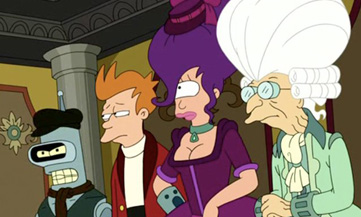|
|
MythologyBreaking Bad and FuturamaBy Martin FelipeAugust 15, 2011
When last I spoke of Bad, I compared it to a spaghetti western. I think this style of exaggerated realism has held true in its recent season. The season premiere features an elongated ten minute scene wherein drug kingpin/fast food impresario Gus Fring methodically slaughters one of his henchmen before our heroes Walt and Jessie’s eyes. The tension of the scene builds to an almost unbearable level over the course of a sixth of an hour. Long takes, exaggerated close ups, silences coupled with heightened rhythmic dialogue, all create one of the most intense televised scenes since Tony Soprano ate onion rings while listening to Journey. This is what I mean when I say the show plays by its own rules. The general rule in television is that scenes shouldn’t last more than 30 seconds to a minute, and a minute is pushing it. Yet I can’t imagine a single eyeball turning away from the screen during Gus’s threatening dance of death. This intense block of television suspense is the payoff of three seasons of slightly stylized, true-to-life storytelling. To bring this all back to the mythology, the show explores the contrast between straight laced academia and the world of organized crystal meth in New Mexico, but the oppressive beauty of the landscape coupled with the not-quite-extreme stylization gives the show a gritty, fantastical edge that allows for unconventional though oh so effective, moments like the one above. The show plays in its version of the real world, no hobbits or vampires here, but it does so in a way that heightens the reality to the point where it gives the New Mexican desert an almost supernatural quality, ominous and foreboding.
|

|
|
|

|
Friday, November 1, 2024
© 2024 Box Office Prophets, a division of One Of Us, Inc.


